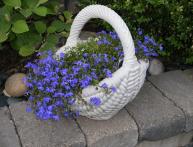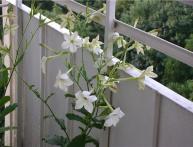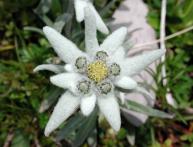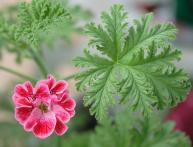Planting and caring for liatris

From the vast expanses of the fertile valleys of North America, a strict and fragrant liatris. This is an unpretentious perennial of the Asteraceae family, which looks like a large candle.
Content:
Features of flowering
Liatris blooms quite unusually and for quite a long time. Tubular flowers begin to bloom from top to bottom, gathering into a fluffy inflorescence - a panicle. It begins to bloom only when the whole peduncle blooms. Depending on the plant variety, the flowers have a wide range of shades - from bright purple to boiling white. The various shades of flowering ears combined with the subtle aroma of vanilla evoke a whole storm of emotions.
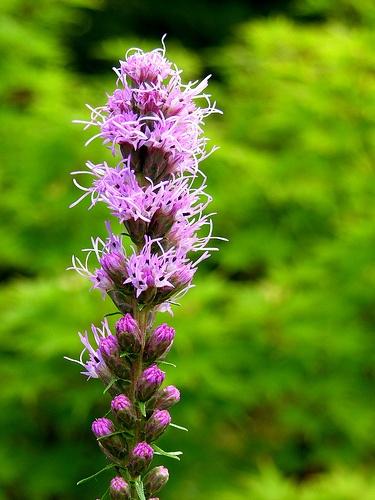
The chemical composition of plant juice includes coumarin, a natural flavoring agent used in perfumery to make essential oils. A dried liatris branch can retain its natural aroma for a long time.
Liatris combines many characteristics and qualities inherent in other flowers individually: aroma, unpretentiousness, originality and beauty. Externally, liatris resembles a popsicle on a stick. The flowering period begins in the first half of July and ends in the last third of August.
Landing Features
Liatris is planted mainly in the flower beds. Often used in compositions on alpine slides. Also, the flower is grown “for cutting” and stands in water for a long time.
To plant liatris, choose an open and well-lit place. Shaded places play a negative role in the growth, flowering and color of the flower.
The plant prefers loose and well-drained soil. Therefore, planting and caring for liatris is carried out on dry soils, avoiding the proximity of groundwater. Liatris does not tolerate heavy clay and damp substrates with reduced relief, but it does well during dry periods.
Features of care
Caring for liatris is not difficult. The plant begins to be planted from late April to early May. The planting depth reaches up to 10 cm and depends on the size of the tuber. The main thing in planting is not to confuse the lower and apical parts. The upper part of the tuber has a recess from which a stem sprouts in early June. Liatris does not like excess moisture, as the tubers are susceptible to rotting. In winter, it does not require special closing. It will be enough to sprinkle the base of the stems with humus or fallen leaves in a layer of up to 15 cm.
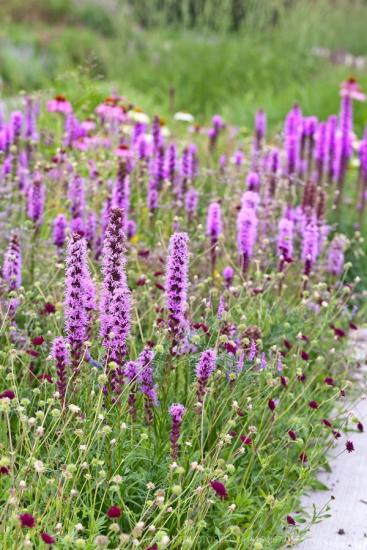
Further care for liatris is watering with small doses of mineral fertilizers. After the plant has flowered, the above-ground part is carefully cut off.
Liatris tolerates replanting quite easily even in the flowering state. Propagated by dividing the tuber or seeds. Sown in early spring or autumn directly into the ground. Excellent for planting seedlings. Young bushes begin flowering at the age of three.
Common varieties
The most popular varieties of Liatris:
- Liatris spicata. The plant reaches 80 cm in height. There are 6 colors of this variety: white, violet, pink, purple, lilac and azure.
- Liatris membranous.With a tall peduncle reaching one meter, bearing white or bright pink inflorescences.
- Liatris rough. The tallest representative of this plant group. Peduncles reach a height of up to two meters. The flowers are small, bright purple in color, collected in fluffy inflorescences - panicles.
Liatris roots are nodules that look like flattened bulbs. They are connected to each other by thin roots, forming a single plant organism from which the bush itself grows. In sunny places, liatris grows very rapidly. Its leaves and flowers are intensely colored. Often, under such conditions, the height of the peduncle can reach 1.5-2 meters.
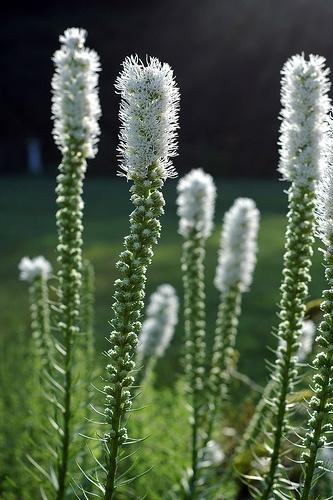
In conclusion, it can be noted that the use of liatris in landscape design is very productive. Tall and medium-sized varieties are used to decorate complex mixborders. Low varieties of liatris are used in the formation of alpine slides. In rose gardens they are used to frame stone candlesticks and fountains. Liatris goes well with other plants: flowering shrubs, such as lush hydrangeas. It can often be found surrounded by broad-leaved ferns. Liatris also gets along well with other aromatic plants, for example, phlox. When forming a flower bed, liatris is planted in a circle, resulting in a very beautiful bush.
Liatris is jokingly called the “lazy flower” for its unpretentiousness and low susceptibility to pathogens and pests. All types of liatris are excellent honey plants. Liatris rightfully takes its rightful place in the garden plots of both an experienced gardener and a novice amateur.




